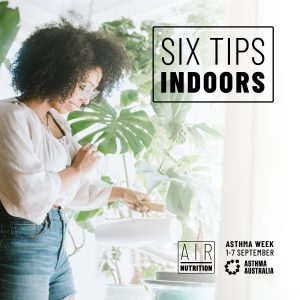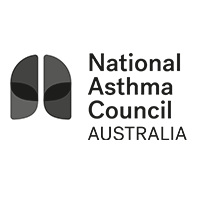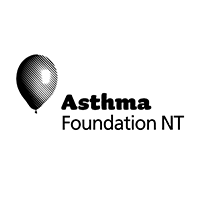
ASTHMA WEEK, 1-7 SEPTEMBER
2.7 million of us are living with asthma (1 in 9). Asthma Australia together with the The Asthma Week Collaborative is launching – ‘Air Nutrition – you are what you breathe – to educate Australians to think differently about the air we’re breathing in and to take simple steps to reduce our intake for a healthier life.
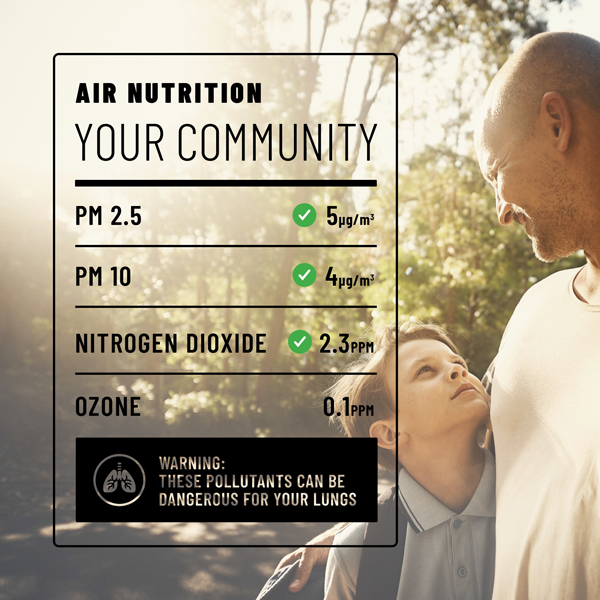
WHAT IS GOOD AIR NUTRITION?
Air Nutrition starts with caring as much about the air you breathe as the food you eat when it comes to your daily health and wellbeing. Good Air Nutrition is linked to better health and a lower risk of getting unwell and experiencing respiratory symptoms especially if you have a condition like asthma.
Improving your Air Nutrition is to reduce the amount of air pollution you breathe in – at home, in your community and in our natural and built environment. Air pollution comes in many forms and it is unhealthy for everyone. Over time, breathing it in leads to increased risk of poorer health including asthma, stroke, heart and lung diseases, and cancer. Understanding what causes air pollution, the forms it takes and how to avoid it, is a key part of staying healthy with good Air Nutrition.
Check your local air quality here.
WHAT IS AIR POLLUTION?
CLICK TO LEARN ABOUT EACH POLLUTANT

PM2.5
Sources



Smoke from fires including woodfire heater smoke, bushfires, hazard reduction burns; car and truck exhaust, industry-related pollution.
Air Nutrition
It can be very unhealthy for human health. PM2.5 impacts your health at very low concentrations. Short and long term exposure is directly linked to risk of worsening heart and respiratory disease, asthma, stroke and cancer with links to premature deaths. When exposed it also causes irritation to your eyes, nose and throat. So far, no safe level of exposure has been determined for human health. For those at risk, it increases hospitalisations and for pregnant women it’s connected with premature births, low birth weight, perinatal complications.
There is no hourly standard set in Australia for breathing in PM2.5, even though we see hourly peaks of extremely high levels in dust and smoke events. For one day, an acceptable daily level is 25ug/m3 or less and over a year is an average level of 8 ug/m3 or less.
What is PM 2.5
Tiny particles of various substances including several chemical compounds, combustion materials and also include sea spray. They are so small they are easily inhaled deep into your lungs where they can cause damage and can cross into our blood stream affecting heart conditions and increased risk of stroke. They are 2.5 micrometers and smaller.

PM 10
Sources




Smoke from fires including woodfire heater smoke, bushfires, hazard reduction burns; car and truck exhausts and industry, sea salt and dust (such as dust from unsealed roads)
Air Nutrition
Very unhealthy. PM10 gets into your throat and lungs causing harm and irritation including cough, runny and blocked nose and eye irritation. PM10 can cause and worsen symptoms of asthma (cough, difficulty breathing, wheeze and chest tightness) and heart conditions.
There is no hourly standard set in Australia for PM10, even though we see hourly peak of extremely high levels in dust and smoke events. The acceptable one day exposure is 50 ug/m3.
What is PM10
Small particles found in dust and smoke which are produced by vehicles on dirt roads and dusty industrial activities. PM2.5 particles are included in PM10 classifications.
 OZONE (03)
OZONE (03)
Sources



Car and truck exhaust, industry, coal-fired power stations and bushfire smoke
Air Nutrition
Harmful – Ozone irritates the upper airways and gets into the lower airways. It can cause irritation of eyes, nose, throat and lower airways triggering breathing problems and asthma. Ozone can be a cause of reduced lung function and chronic lung disease. Most sensitive groups include children, the mature aged and those with lung conditions.
The national acceptable hourly standard is 65 ppb over 8 hours. No exceedances.
What is Ozone
This is not the ozone layer, but a gas found at ground level. It is produced by the chemical reaction between various chemical compounds that are pollutants emitted from other sources. It causes smog, a mix of smoke and fog produced when sunlight reacts with other volatile organic compounds. Ozone is higher during summer.
 SULPHUR DIOXIDE (SO2)
SULPHUR DIOXIDE (SO2)
Sources



Coal fired power stations, metal smelting, diesel vehicles, oil refineries, and shipping
Air Nutrition
Harmful to those most at risk. Exposure will cause irritation of the eyes, nose, throat and lungs. High exposure is linked with asthma symptoms and attacks leading to increased hospitalisation for breathing difficulty. Each 10ppb increase in SO2 is linked to increased hospitalisations for asthma.
The national standards are 0.1ppm averaged over 1 hr. From 2025 the acceptable levels will be 0.075ppm over one day and 0.02 over one year.
What is Sulphur Dioxide
A colourless gas with a strong pungent smell produced when burning sulfur containing fossil fuels and mineral ores. When it combines with water, it forms sulfuric acid, the main component of acid rain.
 CARBON MONOXIDE (CO)
CARBON MONOXIDE (CO)
Sources





Burning fossil fuels including natural gas, petrol, coal and oil; smoke from fires; car and truck exhaust faulty gas heaters, gas cook tops, ovens and BBQs
Air Nutrition
Usually harmful inside. Carbon Monoxide causes health effects but is most likely to cause harm when allowed to build up inside, such as from gas appliances. It can be harmful for pregnant women and the health of their babies and people with heart conditions. It reduces the amount of oxygen getting to the body’s organs – heart and brain – and tissues. High exposure results in flu-like symptoms (headaches, dizziness, disorientation, nausea and fatigue). CO2 can cause chest pain.
According to EPA Victoria, the acceptable level of CO is 30 ppm over an 8-hour period
What is Carbon Monoxide
A colourless and odourless gas that forms the carbon contained in fuels doesn’t burn completely. While outdoors carbon monoxide is usually sourced from motor vehicles, industry and bushfires, indoors CO is formed by unflued gas heaters, wood-burning heaters and cigarette smoking.
Carbon monoxide levels are typically higher during cold weather as cold temperatures makes combustion less complete and traps pollutants close to the ground.
 NITROGEN DIOXIDE (NO2)
NITROGEN DIOXIDE (NO2)
Sources




Exhaust from trucks and cars, gas heaters and cookers (combustion processes), coal-fired power stations, ships, and industry. Found in nearly 80% of Aussie homes due to gas use.
Air Nutrition
Harmful – irritates the lungs. Directly linked to asthma in children, asthma symptoms and can inflame airways in all people. In people with asthma, NO2 can increase the risk of developing lung infections, increase the risk of reacting to triggers like pollen or exercise, and worsen asthma potentially causing more frequent asthma attacks. NO2 may also be associated with reduced lung function.
The national acceptable standards for nitrogen dioxide are 0.08 ppm averaged over 1 hour and 0.015 ppm (15 ppb) averaged over 1 year.
What is NO2
Nitrogen Dioxide is a highly reactive gas. It contributes to ground-level Ozone as well as particulate matters such as nitrate aerosols which form an important part of PM2.5.





 1800 278 462
1800 278 462





 OZONE (03)
OZONE (03) SULPHUR DIOXIDE (SO2)
SULPHUR DIOXIDE (SO2) CARBON MONOXIDE (CO)
CARBON MONOXIDE (CO)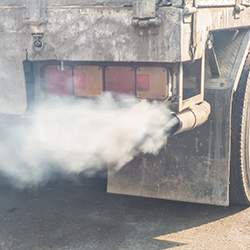 NITROGEN DIOXIDE (NO2)
NITROGEN DIOXIDE (NO2)
